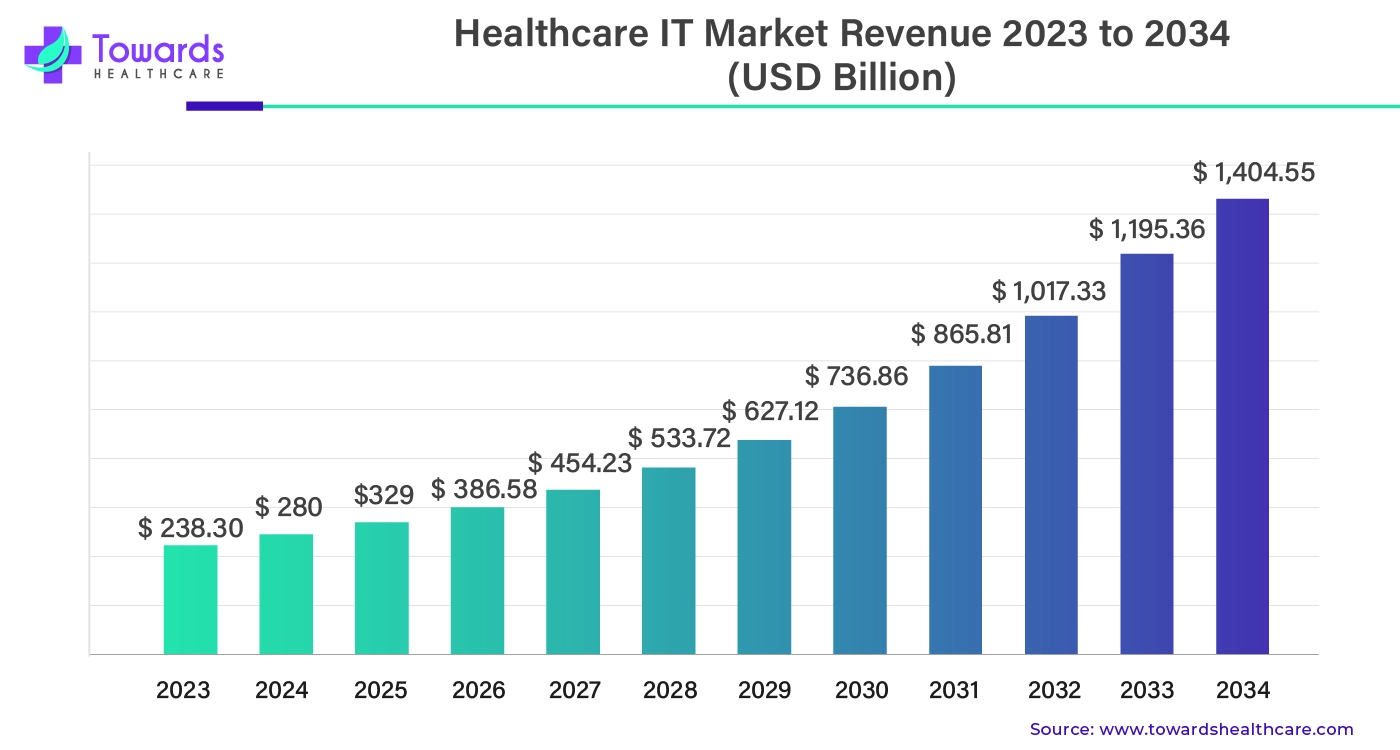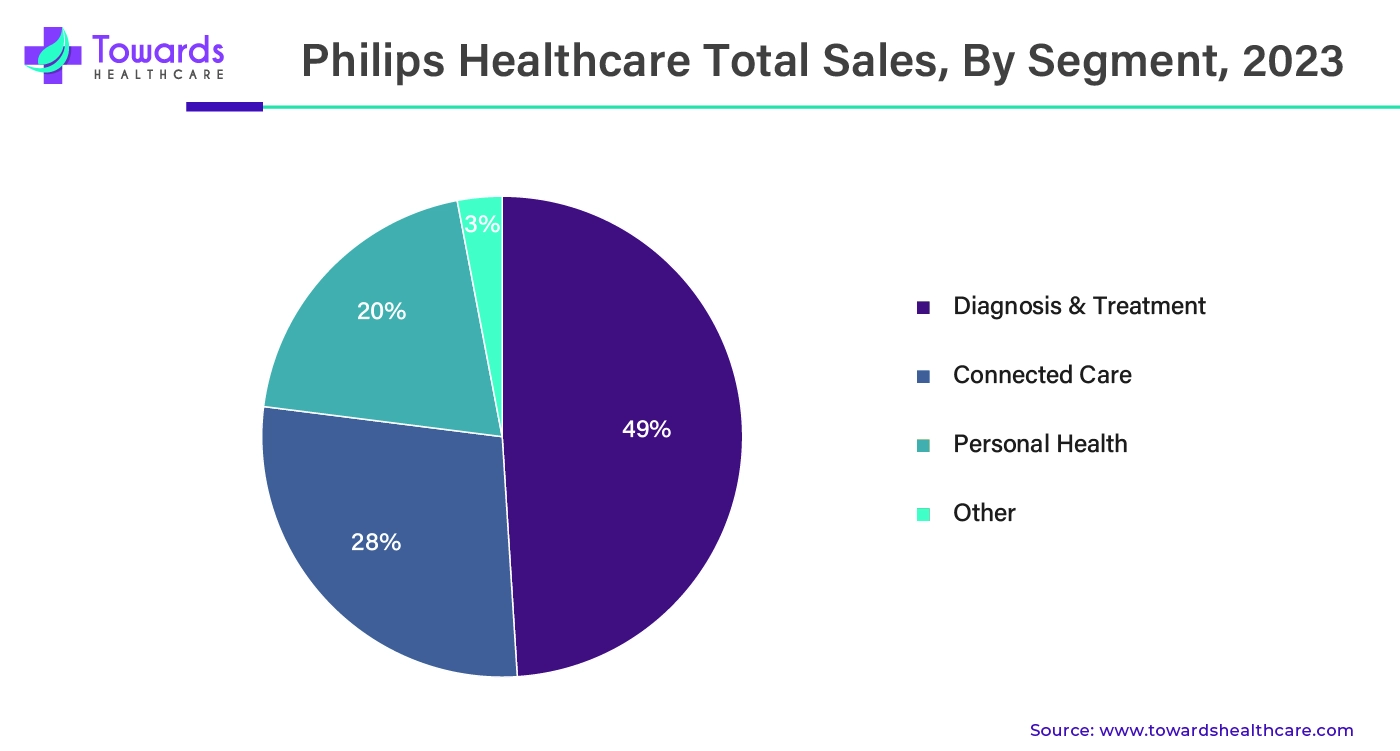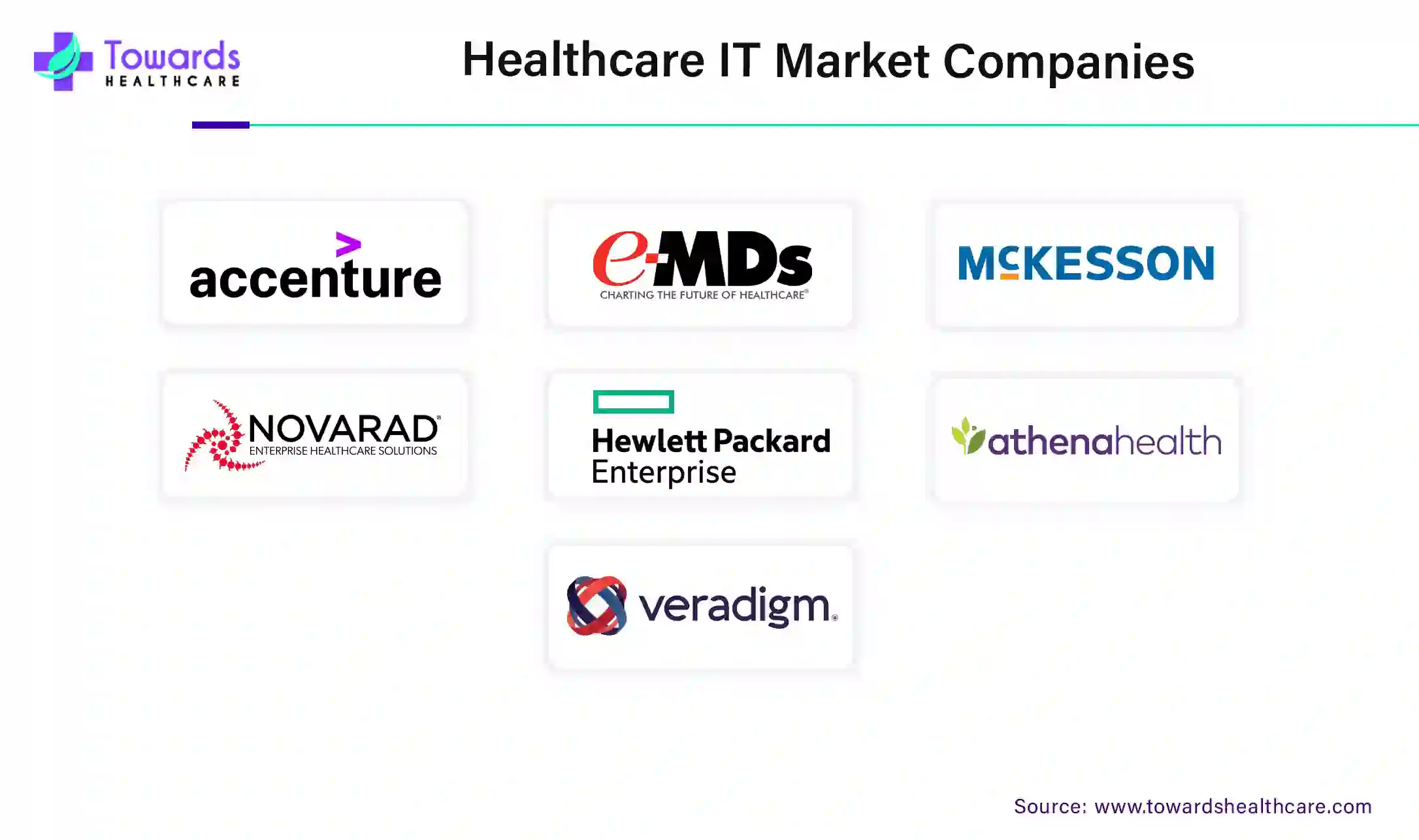March 2025


Principal Consultant

Reviewed By
The global healthcare IT market was estimated at US$ 238.30 billion in 2023 and is projected to grow to US$ 1404.55 billion by 2034, rising at a compound annual growth rate (CAGR) of 17.5% from 2024 to 2034. With the growing number of population and health issues, a lot of data is generated. It becomes easy to manage that data with IT; therefore, incorporation of IT in healthcare becomes essential.

The healthcare IT market provides services related to the maintenance, development, use, and creation of information systems. IT covers networks, computers, software, storage devices, databases, and infrastructure, which are used by healthcare professionals, patients, and third parties (government bodies, insurance companies, healthcare facility management companies, etc.) to work together to run healthcare facilities and provide a high-quality patient experience. IT in healthcare is to manage data, develop treatment plans, manage staff data, make accurate diagnoses, manage financial data, heat management applications, conversational systems, electronic bills, resource management, equipment management, and many more applications associated with the incorporation of Information Technology (IT) in the healthcare industry.
Artificial intelligence has become an important component of information technology and is also playing a significant role in technological advancements in healthcare. AI is being used in almost all healthcare systems, whether it is associated with patients, staff, or any other aspect. AI is helpful in analyzing patient data, developing better treatment plans, monitoring patients, developing personalized treatments, disease identification, data sorting, etc. AI reduces the chances of human errors, reduces time in different processes, and increases efficiency & accuracy. Apart from this, AI plays a significant role in the research and development of new therapeutics and drugs. AI can analyze large data produced during clinical trials and predict outcomes.
Furthermore, AI is also useful in patient care apps, which are developed to provide telehealth. Such applications have AI-generated healthcare plans and chatbots to help patients solve their queries. Such applications are highly useful in providing therapies to mental health patients who need continuous support. AI has endless applications in healthcare, and with more technological advancements, AI-based systems are further going to enhance the healthcare sector.
For instance,
Philips is responsible for providing innovative solutions in healthcare for prevention, healthy living, treatment, diagnosis, and home care. In 2023, Philips Healthcare improved the lives of 1.88 billion people, among which 221 million people belonged to underserved communities. The company’s goal is to improve the lives of 2.5 billion people by 2030, which will include around 400 million underserved communities. The following pie chart talks about the sales generated by Philips Healthcare in the year 2023 by providing healthcare IT services.

One of the major roles of healthcare information technology is managing patient data, which includes personal and medical records. Information technology is used in the diagnosis, treatment, and monitoring of patients. Various applications have also been developed for remote monitoring of patients, e-prescriptions, telehealth, personalized health solutions, healthcare assistants, etc. Information technology makes it easy for healthcare professionals to allocate work and analyze patients. It is also useful in managing the financial aspects of healthcare. With a growing number of disorders and chronic conditions, there has been an increase in the number of hospital admissions, and in the future, the number is going to increase. With the increased number of patients, the usage of healthcare IT is going to increase.
Data generated in healthcare is digitally stored and processed for further use. Highly sensitive data includes personal and medical information of patients, genetic data of patients, staff data, financial data, and research data. All these data are at high risk of cyberattack and unethical use. Lack of proper security systems can lead to data theft, which can cause financial losses, compromised patient care, and damage to the organization's reputation. Therefore, ensuring data privacy & security is a major challenge that needs to be overcome by the healthcare industry.
Extended reality (XR) is an umbrella term for virtual reality (VR), augmented reality (AR), and mixed reality (MR). It holds great potential for market growth. With the help of extended reality, healthcare professionals will be able to experience more realistic training and surgery practice. In the case of patients, XR is highly useful in remote health, having training sessions with healthcare professionals, etc. XR can prove to be highly useful in managing mental health by providing therapies and sessions. AR and VR can enhance the overall experience of therapy sessions.
For instance,
By type, the healthcare provider solutions segment held the largest share of the healthcare IT market in 2023. In order to provide effective and efficient patient-centered care and improve health outcomes, provider organizations, hospitals, physician groups, and government healthcare agencies collaborate. A broad range of goods and services intended to assist healthcare providers in enhancing the standard of care, streamlining their business processes, and controlling expenses are referred to as "healthcare provider solutions." Through acceptance of this digital revolution, healthcare practitioners may confidently maneuver through the constantly evolving healthcare environment.
By end-use, the healthcare providers segment dominated the healthcare IT market in 2023. Information input, transmission, usage, extraction, and analysis in the healthcare industry are all facilitated by systems, software, and hardware that together make up health information technology (HIT). Healthcare insurance companies, public health organizations, pharmaceutical and medical device companies, regulatory and quality assurance bodies, medical researchers, and different governmental levels are among the end-users of this technology, in addition to patients, doctors, and other front-line healthcare providers.
Healthcare Providers use health information technology from antibiotics and anesthetics to radiotherapy and MRI scanners. Personalized healthcare options, medical practice management software, remote monitoring of patients, and other applications are used in clinical, hospitals, and medical facilities. These factors help healthcare providers stay competent and relevant to match the pace of technological advancements and provide the utmost quality of care.
By region, North America held the largest share of 41% in the healthcare IT market in 2023. When it comes to technological advancements, North America is the leading region, with countries like the U.S. and Canada contributing to the growth of the Healthcare IT market. The government of the U.S. and Canada heavily invests in technological advancements and healthcare infrastructure.
The U.S. majorly contributes to the healthcare IT market due to its advanced healthcare industry. Another factor that contributes to the market’s growth is the growing number of patients due to various chronic conditions. As AI, machine learning, and other technologies are being incorporated into the healthcare sector, the market is growing even further.
The U.S. has a large hospital base, including government and non-government hospitals. The table below provides statistical data about the number of hospitals in the U.S. and the total number of hospital admissions. The data is valuable for understanding the vast use of IT in hospitals and for managing patient data.
By region, Asia Pacific is observed to grow at the fastest rate during the forecast period. Population growth plays a significant role in the growth of the market. 60% of the world’s population resides in the Asia Pacific, which is equivalent to 4.3 billion people. India (141.72 crores) and China (141.22 crores) are the two countries with the largest populations and belong to the Asia Pacific Region. A large population means a larger number of diseases and disorders and increased hospital admissions. A large hospital base is needed to support the large number of patients, which promotes the use of information technology. The large amounts of generated data need to be managed and stored for further use, which requires IT.
India is significantly contributing to the growth of the healthcare IT market with the Digital India initiative. The purpose of this initiative is to digitally empower India. Under the Digital India initiative, the Ayushman Bharat Digital Mission (ABDM) was created to build a digital health ecosystem. Over 51.75 crore Ayushman Bharat Health accounts, over 30.16 crore Ayushman cards, over 33.45 crores ABHA linked health records, over 2.28 lakh health facilities registered, over 2.65 lakh healthcare professionals registered, and over 54.39 lakh health records app downloads were done under ABDM.
| Total No. of Hospitals in the U.S. | 6,120 |
| The U.S. Community Hospitals | 5,129 |
| Number of Nongovernment Not-for-Profit Community Hospitals | 2,987 |
| Number of Investor-Owned (For-Profit) Community Hospitals | 1,219 |
| Number of State and Local Government Community Hospitals | 923 |
| Number of Federal Government Hospitals | 207 |
| Number of Nonfederal Psychiatric Hospitals | 659 |
| Other Hospital | 125 |
| Total Admissions in All U.S. Hospitals | 33,679,935 |
| Admissions in Community Hospitals | 31,555,807 |
| Number of Rural Community Hospitals | 1,810 |
| Number of Urban Community Hospitals | 3,319 |
| Number of Community Hospitals in a System | 3,510 |
Deepak Sahni, CEO of Healthians, commented in a recent interview that artificial intelligence (AI) aids in diagnostic processes, continuous monitoring, and insightful data-driven analytics. This rapidly emerging trend facilitates decentralized healthcare services, ultimately enabling proactive and personalized healthcare interventions.

| Company Name | IBM |
| Headquarters | New York, U.S., North America |
| Recent Development | In January 2022, IBM signed a definitive agreement with Francisco Partners in which it agreed to transfer all the healthcare data and analytics assets. The deal was closed for $1,065 million for the U.S. and Canada. The assets included clinical development, MarketScan, health insights, social program, management, imaging software, and Micromedex. The closing was completed in other countries as well, and in December 2023, a $303 million pre-tax gain was recognized. |
By Type
By End User
By Region
March 2025
March 2025
March 2025
March 2025